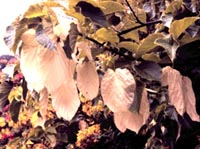Resource Library
Plant of the Week: Handkerchief Tree (Dove Tree)
The University of Arkansas System Division of Agriculture does not promote, support or recommend plants featured in "Plant of the Week." Please consult your local Extension office for plants suitable for your region.
Plant of the Week
Dove Tree, Handkerchief Tree
Latin: Davidia involucrata

Some people are afflicted with a keen interest in natural history and those with a
botanical leaning, are attracted to all manner of new and unusual plants. Some of
us are doubly afflicted -- not only having interest in plants but we also have the
collecting disability. When a new plant comes along, it must be secured. Such was
the case with the dove tree when the English nurseryman, Sir Harry Veitch (1840-1924)
learned of its existence in Western China.
The dove tree is a deciduous member of the nyssa family and attains a height of 35
feet, with a more or less pyramidal form. Leaves are heart-shaped and coarse textured.
The flowers consist of a button-like mass of stamens which are surrounded by a pair
of white bracts. The lower bracts can be three inches wide and six inches long with
the upper about half that size. When the trees bloom in late spring it is robed in
fluttering white flowers and it becomes apparent why it has such unusual common names.
The tree was brought to the attention of the Western world by Abbe Armand David (1826
1900), a French missionary in China. In 1862 David was assigned to teach science and
natural history classes to children enrolled in the order’s Beijing mission.
To aid in accomplishing this task he started collecting plant and animal specimens.
He sent one set to the Natural History Museum in Paris.
His contributions were so valuable that the museum persuaded the church officials
to free David of his teaching duties so he could travel throughout the newly opened
parts of China and collect natural history specimens.
On his second trip to southwestern China between 1868 and 1870, he collected two
specimens that made a major impact on the West. Although his discovery of the dove
tree didn’t make as much news as did his introduction of the first living specimen
of panda ever seen in the outside world, the dove tree did excite nurserymen and prompted
them to secure the plant.
Although it was David who first described the tree, its introduction to the nursery
trade was due to Veitch and the plant collector he hired to seek it out, the famous
E. H. "China" Wilson (1876-1930).
The location of a dove tree was given to Wilson, and after considerable effort he
found the tree only to find a stump and a new house built from its logs. Fortunately
for gardeners he discovered other trees in bloom about two weeks later and shipped
seed back to England in 1901.
The dove tree is a rare tree in the nursery trade and landscapes of North America.
It grows in Zones 6 to 8 and will grow throughout Arkansas, yet I know of no flowering
size trees in the state. It should be given a little afternoon shade and a rich, high
organic matter soil that is well drained but kept more on the moist side than the
dry side. It is slow to flower, usually taking at least 15 years from seed. It sometimes
shows alternate year flowering, but when it does bloom its beauty and rarity is worth
the trouble it takes to grow.
By: Gerald Klingaman, retired
Extension Horticulturist - Ornamentals
Extension News - June 4, 1999
The University of Arkansas System Division of Agriculture does not maintain lists of retail outlets where these plants can be purchased. Please check your local nursery or other retail outlets to ask about the availability of these plants for your growing area.